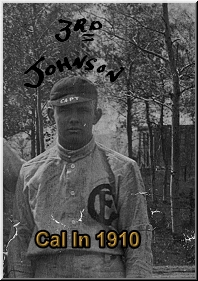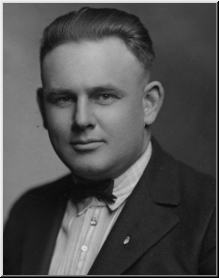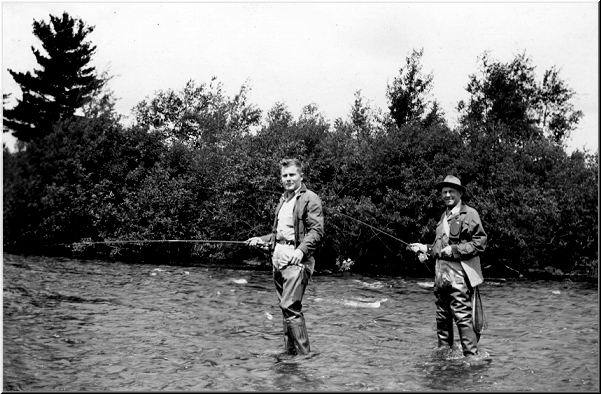Although most of today’s musky hunters may recognize the name of
Cal Johnson as the person who had caught the world record musky
in 1949, time has had a way of dimming most of the other
accomplishments of his prolific angling and outdoor career.
While the catching of his 67½# world record musky was certainly
remarkable, that event was but the crowning achievement in the
sporting life of one of America’s greatest outdoor
personalities.
Because Cal’s prime years occurred so long ago, most of today’s
sportsmen have no idea of the scope of this man’s outdoor
credentials. Cal Johnson was a man of the caliber and fame of a
Zane Grey or an Al Lindner; a man who had set up fishing trips
for two United States Presidents; and a man who was famous for
being a champion of conservation along with the founders of the
much revered Izaak Walton League. During the 1920s, 30s, and
40s, Cal Johnson gave fishing, outdoor, and conservation
lectures all over North America; he had his own popular outdoor
radio show on NBC radio which aired throughout the Midwest; and
he even did one of the earliest television broadcasts in the
Chicago area. He was a champion bait and fly caster and
instructor and one of the most prolific angling and outdoor
writers of all time.
 Born on December 15, 1891 in Phillips, Wisconsin, Calmer Lansworth
Johnson began following nature’s path early in life, often
hopping trains to get to his favorite trout fishing creeks. In
addition to his interest in fishing, Cal was also quite the
athlete during his younger days. In 1910, Cal leadership
abilities gained him the opportunity to be named as the captain
of the baseball team that he played for. Moreover, after
dedicating himself to building up his body by the mid Teens,
young Cal earned quite a reputation as a competitive wrestler.
Born on December 15, 1891 in Phillips, Wisconsin, Calmer Lansworth
Johnson began following nature’s path early in life, often
hopping trains to get to his favorite trout fishing creeks. In
addition to his interest in fishing, Cal was also quite the
athlete during his younger days. In 1910, Cal leadership
abilities gained him the opportunity to be named as the captain
of the baseball team that he played for. Moreover, after
dedicating himself to building up his body by the mid Teens,
young Cal earned quite a reputation as a competitive wrestler.
Just after World War I, after working as a clerk at a men’s
clothing store in Ashland, Wisconsin, that he had an interest in
had failed, Cal began working in the sporting goods industry.
In 1919, Cal served as a special game warden at large, during
which time, it allowed him to study conservation conditions
first hand, something that even further broadened a mind that
was already brimming with a great store of outdoor lore. It
was around that time when he began spending many a late night
studying books on journalism, eventually selling his first
articles to the Milwaukee Journal and other magazines.
 After quitting his job in the sporting goods field, Cal finally
realized his dream as a writer and took an editorial position
with the Land-O-Lakes Bulletin under the name of
“Wisconsin Cal.” Over the years Cal also wrote under other pen
names like “Capt. Jack Spar” and “What the old guide says.”
This led to bigger things and, by 1924, Cal had moved to South
Bend, Indiana, and became a promotional writer for the South
Bend Bait Company and the Johnson Motor Company. It was while
living there in Indiana that Cal and his wife Helen were blessed
with their only son Philip. Over the years, young Philip would
accompany his father on many a fishing adventure.
After quitting his job in the sporting goods field, Cal finally
realized his dream as a writer and took an editorial position
with the Land-O-Lakes Bulletin under the name of
“Wisconsin Cal.” Over the years Cal also wrote under other pen
names like “Capt. Jack Spar” and “What the old guide says.”
This led to bigger things and, by 1924, Cal had moved to South
Bend, Indiana, and became a promotional writer for the South
Bend Bait Company and the Johnson Motor Company. It was while
living there in Indiana that Cal and his wife Helen were blessed
with their only son Philip. Over the years, young Philip would
accompany his father on many a fishing adventure.
Serving as the director of fishing trips for Presidents Coolidge
and Hoover and various other celebrities, Johnson was a
nationally acclaimed bait and fly caster and was featured in
several fishing expeditions by the Canadian Motion Picture
Bureau. Two of his feature films, “The Quest of the Bronze
Back” and “Fishing Gamely for Game Fish” were wildly
popular with fishing clubs across America during the late
1920s.
A man of the highest sporting ethics and an ardent believer in
the ideals of the Izaak Walton League, Cal became that
organization’s public relations director and editor of their
official magazine, Outdoor America, around 1929. As
editor of this magazine, Cal courageously wrote about how the
consequences of unbridled industrialization could threaten the
future of our great woods and waters. By that time, Cal was
living in downtown Chicago, writing a syndicated column in
hundreds of newspapers across the country. Spreading the gospel
of good conservation and sportsmanship whenever he could, Cal
also served as the long time angling editor of Sports Afield
magazine and has written many pamphlet books on fishing for
various companies.
On Valentines Day in 1929, while working as an outdoor writer
for the Chicago Daily News, Cal caught wind of one of the
city’s most infamous events, the St. Valentine’s Day Massacre,
shortly after it had happened. Being close to where this
horrific event had occurred, Cal decided to go down to the
garage on N. Clark Street, where the shooting took place, to
check out the scene. Cal had arrived so quickly at the scene,
that the shot up victims were still lying mortally wounded where
they had fallen. For whatever reason at the time, Cal happened
to have his young son Philip with him. Philip, who was only
about three years old at the time, inquisitively remarked to his
father, “How come those men on the ground are sleeping?” Little
Philip was too young to grasp the reality of what he was seeing.
During the early 1930s, Cal Johnson had become known as a famous
outdoor radio personality. Because the newspaper that he wrote
for, the Chicago Daily News, owned WMAQ radio station in
Chicago, Cal was chosen to host his own fifteen minute outdoor
radio show at WMAQ. After the National Broadcasting Company
(NBC) purchased WMAQ in 1931, Cal Johnson continued on with his
popular show, which was then broadcasted to an even larger
audience. It was at that time that Cal met and worked along
side other popular Chicago radio acts such as Amos ‘N Andy
and Fibber McGee and Molly. In 1931, NBC also acquired
WENR radio, where they gave Cal Johnson another outdoor show,
entitled “Cal’s Johnson’s Outdoor Lore”, to be aired on that
station’s regular Monday evening line up. So, by the early
1930s, Cal Johnson’s radio show was on two different stations
and was reaching listeners all throughout the Midwest.
On November 28, 1931, Cal Johnson was also featured on one of
Chicago’s earliest television broadcasts. Although few people
had television receivers at that time, this early broadcast,
which featured Johnson with a musky, serves as a
groundbreaking achievement in the annals of outdoor
broadcasting. In all likelihood, this musky was the first musky
in the history of television to ever be aired to the public.

Cal Johnson and
His Son Fly Fishing
Clearly one of the most prolific angling writers of all time,
more than seventy years ago Cal had already written about many
of the same angling methods which some of today’s professional
fishermen have claimed that they have only recently discovered.
Topics like fishing deep for suspended muskies, night fishing,
using smaller hooks and barbs in order to have better hooking
potential, and not using live bait swallow hook rigs because it
causes more mortality in one’s fishing: were all things that Cal
had written about many years ago. In reality, much of what we
are doing today had already been done and talked about by our
predecessors like Cal Johnson. Those “old timers” knew much
more than we sometimes give them credit for.
In addition to his many years as Sports Afield’s fishing
editor, Cal also wrote for Outdoor Recreation, Esquire,
and Liberty magazines, as well as writing books on fly
fishing for bass, night fishing, and fishing tips. During the
1940s, Cal also served as a representative for Champion Motors
and Aluma-Craft boats. During World War II, even though he was
past fifty years of age, Cal Johnson answered the call to do his
part for our nation by serving in the United States Coast Guard
Auxiliary. Around 1943, Cal Moved to Minneapolis Minnesota,
where in addition to his other enterprises, he also acted as the
master of ceremonies for the Minneapolis Sport Show.
Because he had rheumatic fever when he was younger, around 1947,
Cal’s doctor informed him that he had a serious heart condition
and likely had only months to live, recommending that Cal quit
his job, get out of the big city and move to the place he loved
the most, and take it easy. So Cal did just that and moved to
the one spot that always held a special place in his heart, Teal
Lake near Hayward.
But Cal wasn’t about to sit around and wait to die; rather he
decided to spend whatever remaining time he had enjoying what he
had always written about–the outdoors. Defying his doctor’s
orders, Cal remained active and spent much of his time fishing,
hiking, and hunting. During the weeks that followed, Cal’s only
son, Philip, began to notice an amazing thing after each
successive visit to see his ailing father; all of the activity
seemed to be improving Cal’s health.
Many months, and then a year, went by and it became apparent
that Cal–who eventually would outlive his own doctor–was going
to stick around for a while. And so it happened… a couple of
years later, on borrowed time, Cal Johnson ended up catching the
world record muskie, 67½ pounds and 60¼ inches of fish! This
muskie, caught on July 24, 1949, out of Lac Courte Oreilles, a
5,039-acre lake near Hayward, currently ranks as the second
largest muskie ever caught and is currently recognized as the
International Game Fish Association’s (IGFA) official world
record muskie.
During his remaining years, Cal Johnson continued with his
writing; he made public appearances at sport shows and for
fishing groups upon request; and he enjoyed sharing the great
outdoors with family and friends. Cal passed away after a heart
attack in 1953, at the age of 62.
Ironically, as outstanding an angling accomplishment as it is,
the catching of this world record musky stands as but the
crowning achievement at the end of a most incredible and honored
career in this outdoor writer’s life. Famous throughout North
America for more than 30 years as one of the most respected
authorities on sport fishing and outdoor life, Cal Johnson was
first and foremost one of the pioneers in the conservation
movement, a gifted and impassioned writer, a much sought after
public speaker at countless functions across the country and
into Canada, a well known outdoor radio personality in the
Midwest, and one of the first to be featured in a number of
motion pictures on fishing.
It was pioneer outdoor writers like Cal Johnson who have broken
the trail and paved the way for the likes of outdoor writers
like A. J. McClane, Jason Lucas, and Jerry Gibbs; television
personalities like Gadabout Gaddis, Virgil Ward, and Al Lindner;
and guides and tackle manufactures like Homer LaBlanc, Tony
Rizzo, and Joe Bucher.
Yes, Cal Johnson is today probably best known as the man who
caught the world record musky in 1949, but there was so much
more to this man than merely this lucky achievement. This
website, hopefully, will give you the reader just a taste of the
other accomplishments that have lead up to this crowning glory
of a most fascinating angling career.